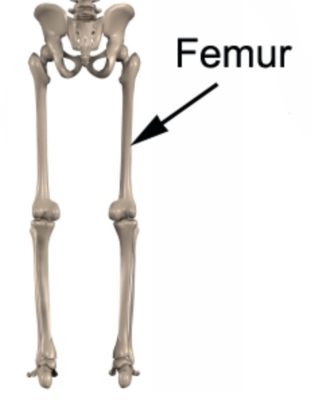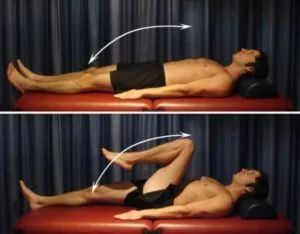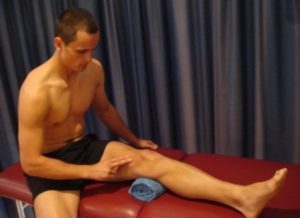Femoral Stress Fracture
Updated:
(Also known as Stress Fracture of the Femur)
What is a femoral stress fracture?
A femoral stress fracture is a condition characterized by an incomplete crack in the femur (thigh bone).
The femur is the anatomical name given to the long bone of the thigh (figure 1).

Several muscles of the hip, knee and thigh attach to the femur. When these muscles contract, a pulling force is exerted on the bone. In addition, weight bearing activity places compressive forces on the femur. When these forces are excessive or too repetitive, and beyond what the bone can withstand, bony damage can gradually occur. This initially results in a bony stress reaction, however, with continued damage may progress to a femoral stress fracture.
Cause of a femoral stress fracture
A stress fracture of the femur typically occurs over time with excessive weight bearing activity such as running, sprinting, jumping or dancing. They often occur following a recent increase in activity or change in training conditions (such as surface, footwear or technique changes etc) and are particularly common in long distance runners.
Signs and symptoms of a femoral stress fracture
Patients with this condition typically experience a poorly localized pain in the front of the thigh that increases with impact activity (such as running, jumping, sprinting and hopping) and decreases with rest. Pain may also cause the patient to cease activity.
Occasionally, pain may radiate to the knee or back of the thigh. In severe cases, walking or standing may be enough to aggravate symptoms. Other symptoms may include night ache, pain when sitting with the thigh over the edge of a chair (especially if a downwards force is applied to the end of the thigh) or pain on firmly touching the affected region of the bone.
Diagnosis of a femoral stress fracture
A thorough subjective and objective examination from a physiotherapist may be sufficient to diagnose a femoral stress fracture. Further investigations such as an X-ray, MRI, CT scan or bone scan are usually required to confirm diagnosis and determine the severity of injury.
Prognosis of a femoral stress fracture
With appropriate physiotherapy management, most patients with a femoral stress fracture can make a full recovery (i.e. return to sport or normal activities) in a period of 3-12 months. In more severe cases, recovery may take 1-2 years, or longer, depending on the intervention required and a range of other factors. In rare cases, some patients may experience ongoing symptoms or complications which may require further management.
Treatment for a femoral stress fracture
Treatment for a stress fracture of the femur typically involves an initial period of rest from weight bearing activity. This may involve a period of reduced activity or the use of crutches for a number of weeks. Following this, a gradual increase in weight bearing activity and exercise can usually occur as tolerated, provided symptoms do not increase. This should take place over a period of weeks to months with direction from the treating physiotherapist and will vary depending on the severity of the injury.
Ignoring symptoms or adopting a ‘no pain, no gain’ attitude is likely to cause further damage and may slow healing or prevent healing of the femoral stress fracture altogether. Immediate, appropriate treatment is essential to ensure a speedy recovery.
Manual “hands-on” therapy from the physiotherapist such as massage, trigger point release techniques, dry needling, joint mobilisation, stretches, and electrotherapy can assist with hastening healing, improving range of movement, pain and function and correcting factors contributing to the development of the femoral stress fracture. This can generally commence once the physiotherapist has indicated it is safe to do so.
Patients should also perform pain free flexibility and strengthening exercises as part of their rehabilitation to ensure an optimal outcome. Alternative activities placing minimal weight bearing forces through the affected bone should be performed to maintain fitness such as swimming, cycling and water running. The treating physiotherapist can advise which activities are most appropriate for the patient and when they should be commenced.
In the final stages of rehabilitation for a femoral stress fracture, a gradual return to activity or sport can occur as guided by the treating physiotherapist provided symptoms do not increase. This may involve a gradual return to running program to recondition the femur to running in a safe and effective manner.
Appropriate footwear advice and / or the use of orthotics may also be indicated in those patients whose lower limb biomechanics are likely to have contributed to the development of the femoral stress fracture. Training technique or training methods may also need addressing to decrease the likelihood of injury recurrence.
Contributing factors to the development of a femoral stress fracture
There are several factors which may contribute to the development of a femoral stress fracture. These need to be assessed and where possible corrected with direction from the treating physiotherapist. Some of these factors include:
- poor foot posture (especially flat feet or high arches)
- muscle weakness (particularly of the gluteals, quadriceps and core stabilisers)
- poor balance
- poor flexibility (particularly of the quadriceps, hamstrings, adductors and calfs)
- joint stiffness (particularly of the ankle, knee, hip or lumbar spine)
- inappropriate footwear
- inadequate diet
- inappropriate or excessive training (particularly on hard or uneven surfaces).
- poor running technique
- menstrual disturbance in females
Physiotherapy for a femoral stress fracture
Physiotherapy treatment for patients with a femoral stress fracture is vital to hasten healing, prevent injury recurrence and ensure an optimal outcome. Treatment may comprise:
- soft tissue massage
- joint mobilization
- joint manipulation
- electrotherapy (e.g. ultrasound)
- dry needling
- the use of crutches
- activity modification advice
- biomechanical correction (e.g. the use of orthotics or foot taping, or, running technique correction)
- footwear advice
- exercises to improve strength, balance, flexibility and core stability
- education
- a gradual return to running / activity plan
Other intervention for a femoral stress fracture
Despite appropriate physiotherapy management, some patients with this condition do not improve and require other intervention to ensure an optimal outcome. The treating physiotherapist or doctor can advise on the best course of management when this is the case. This may include further investigations such as X-rays, CT scan, MRI or bone scan, extended periods of crutches use, review with a podiatrist for possible orthotics or referral to appropriate medical authorities who can advise on any intervention that may be appropriate to improve the femoral stress fracture. Occasionally, patients with this condition may require surgery to stabilize the stress fracture and aid healing.
Exercises for a femoral stress fracture
The following exercises are commonly prescribed to patients with a stress fracture of the femur. You should discuss the suitability of these exercises with your physiotherapist prior to beginning them. Generally, they should be performed 3 times daily once the physiotherapist has indicated it is safe to do so and only provided they do not cause or increase symptoms.
Hip & Knee Bend to Straighten
Take your knee to your chest as far as possible without increasing your pain allowing your knee to bend (figure 2). Then return to the starting position. Repeat 10 – 20 times provided there is no increase in symptoms.

Static Quadriceps Contraction
Tighten the muscle at the front of your thigh (quadriceps) by pushing your knee down into a towel (figure 3). Put your fingers on your inner quadriceps to feel the muscle tighten during contraction. Hold for 5 seconds and repeat 10 times as hard as possible without increasing your symptoms.

Find a Physio
Find a physiotherapist in your local area who can treat a femoral stress fracture.
Physiotherapy products for a femoral stress fracture
Some commonly recommended products by physiotherapists for patients with a femoral stress fracture include:
- Crutches
- Ice Packs or Heat Packs
- Duradiscs or Wobbleboards (for balance exercises)
To purchase physiotherapy products for a femoral stress fracture click on one of the above links or visit the PhysioAdvisor Shop.
Other Exercises
- View more Knee Stretches
- View Hip Stretches
- View Knee Strengthening Exercises
- View Hip Strengthening Exercises
- View Leg Stretches
- View Leg Strengthening Exercises
- View Balance Exercises
More Information
- Read about Correct Footwear
- Read about Foot Taping
- Read about How To Use Crutches correctly

Link to this Page
If you would like to link to this article on your website, simply copy the code below and add it to your page:
<a href="https://physioadvisor.com.au/injuries/thigh/femoral-stress-fracture”>Femoral Stress Fracture – PhysioAdvisor.com</a><br/>PhysioAdvisor offers detailed physiotherapy information on a femoral stress fracture including: diagnosis, treatment, exercises, physiotherapy products and more...
Return to the top of Femoral Stress Fracture.
